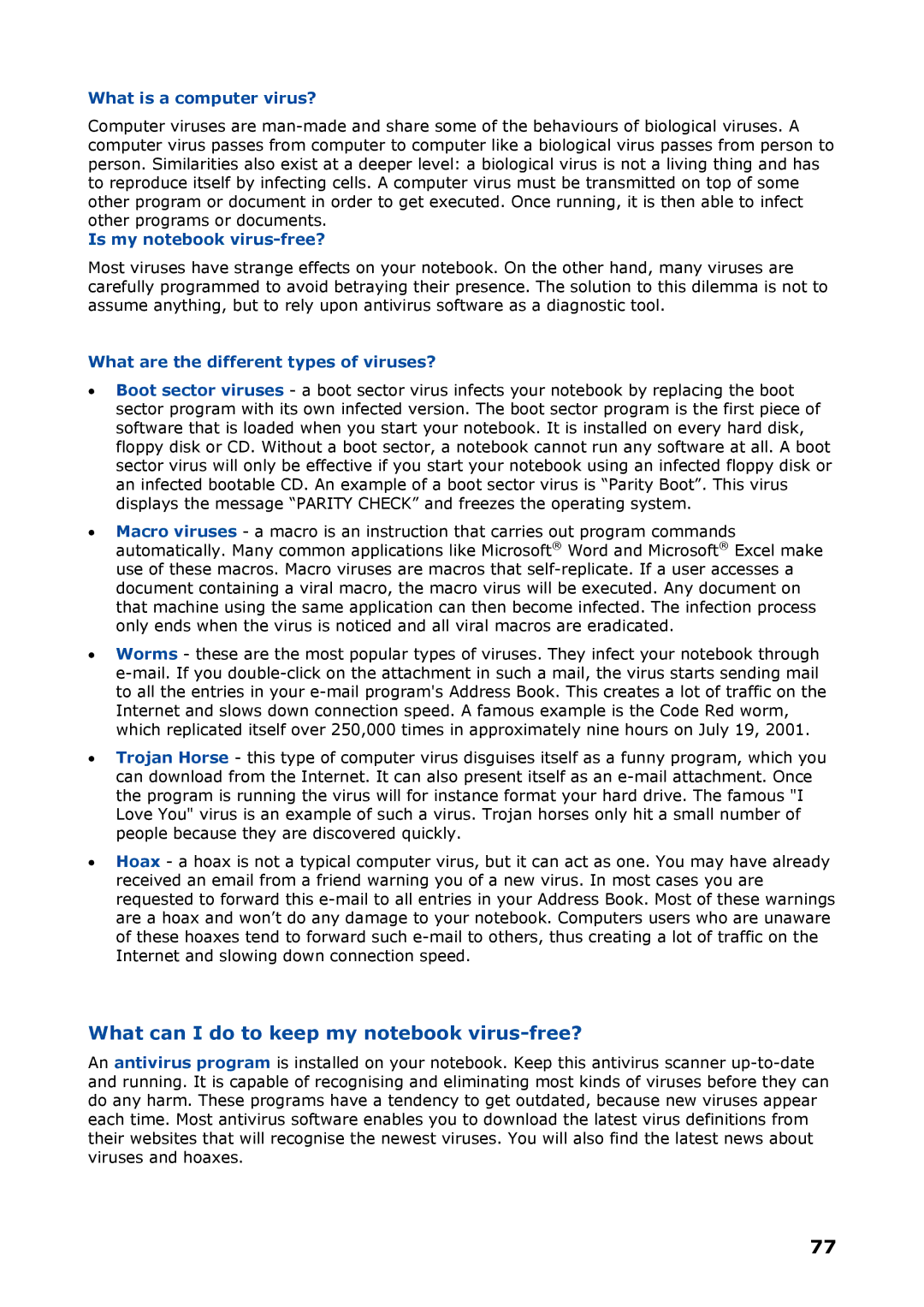What is a computer virus?
Computer viruses are man-made and share some of the behaviours of biological viruses. A computer virus passes from computer to computer like a biological virus passes from person to person. Similarities also exist at a deeper level: a biological virus is not a living thing and has to reproduce itself by infecting cells. A computer virus must be transmitted on top of some other program or document in order to get executed. Once running, it is then able to infect other programs or documents.
Is my notebook virus-free?
Most viruses have strange effects on your notebook. On the other hand, many viruses are carefully programmed to avoid betraying their presence. The solution to this dilemma is not to assume anything, but to rely upon antivirus software as a diagnostic tool.
What are the different types of viruses?
•Boot sector viruses - a boot sector virus infects your notebook by replacing the boot sector program with its own infected version. The boot sector program is the first piece of software that is loaded when you start your notebook. It is installed on every hard disk, floppy disk or CD. Without a boot sector, a notebook cannot run any software at all. A boot sector virus will only be effective if you start your notebook using an infected floppy disk or an infected bootable CD. An example of a boot sector virus is “Parity Boot”. This virus displays the message “PARITY CHECK” and freezes the operating system.
•Macro viruses - a macro is an instruction that carries out program commands automatically. Many common applications like Microsoft® Word and Microsoft® Excel make use of these macros. Macro viruses are macros that self-replicate. If a user accesses a document containing a viral macro, the macro virus will be executed. Any document on that machine using the same application can then become infected. The infection process only ends when the virus is noticed and all viral macros are eradicated.
•Worms - these are the most popular types of viruses. They infect your notebook through e-mail. If you double-click on the attachment in such a mail, the virus starts sending mail to all the entries in your e-mail program's Address Book. This creates a lot of traffic on the Internet and slows down connection speed. A famous example is the Code Red worm, which replicated itself over 250,000 times in approximately nine hours on July 19, 2001.
•Trojan Horse - this type of computer virus disguises itself as a funny program, which you can download from the Internet. It can also present itself as an e-mail attachment. Once the program is running the virus will for instance format your hard drive. The famous "I Love You" virus is an example of such a virus. Trojan horses only hit a small number of people because they are discovered quickly.
•Hoax - a hoax is not a typical computer virus, but it can act as one. You may have already received an email from a friend warning you of a new virus. In most cases you are requested to forward this e-mail to all entries in your Address Book. Most of these warnings are a hoax and won’t do any damage to your notebook. Computers users who are unaware of these hoaxes tend to forward such e-mail to others, thus creating a lot of traffic on the Internet and slowing down connection speed.
What can I do to keep my notebook virus-free?
An antivirus program is installed on your notebook. Keep this antivirus scanner up-to-date and running. It is capable of recognising and eliminating most kinds of viruses before they can do any harm. These programs have a tendency to get outdated, because new viruses appear each time. Most antivirus software enables you to download the latest virus definitions from their websites that will recognise the newest viruses. You will also find the latest news about viruses and hoaxes.
